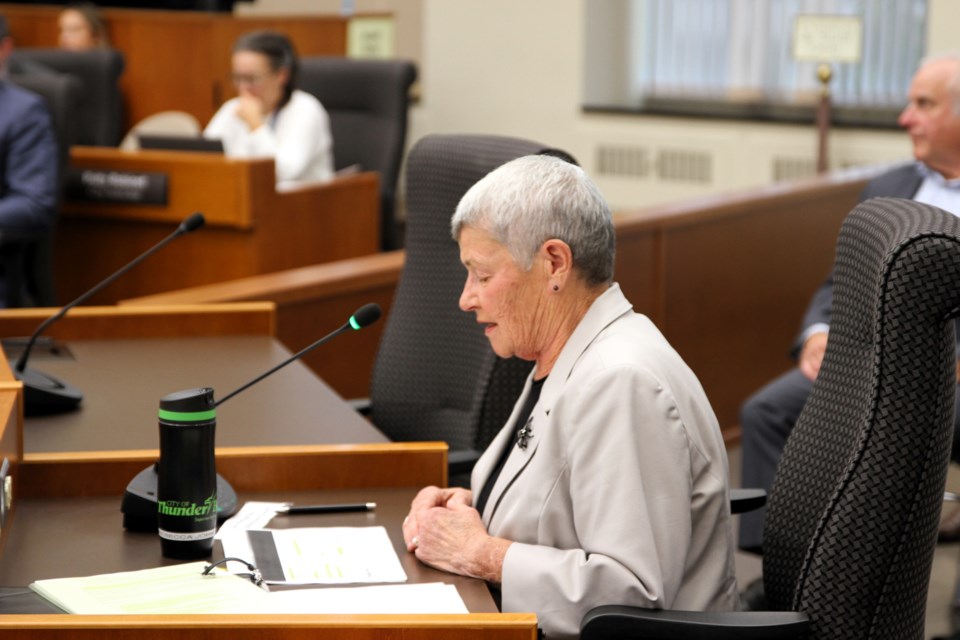THUNDER BAY — Through several consultations with members of the public and targeted groups such as Indigenous groups, administration and councillors, Rebecca Johnson noted that support for the hybrid (wards and at-large) composition of councillors was less desired, and the public wanted to see fewer council positions in the 2026 election.
Since the first phase of the Council Composition Review has concluded, committee chair Johnson presented the committee's findings at Monday night's meeting.
Johnson stated that the number of council members has remained unchanged for the last 40 years; if this council decided to reduce the numbers for the next election, their decision would be a dramatic shift away from what the city has used for the past few decades.
Johnson said, “If you look at the ward system versus the at-large, it's pretty much 50/50. Some people like the ward system, some people like the at-large. There's no real clear definition as to what they would like to have.
“The size of the city council. This is very clear, very clear. It doesn't matter whether it's coming to you as councillors or whether it's coming from the community; they want to decrease the number of councillors around this table.”
Using the committee's online survey data, the average number of council seats the public wants is 8.6 and for the in-person surveys, the average result is 10, according to Johnson.
The committee has committed to 11 council seats, including the mayor.
Johnson presented two options the committee is considering for their recommendation after phase 2 of the review is complete.
Instead of a seven-ward system, there could be four large wards with roughly equal populations, businesses and industries stretching from the waterfront to the city's western boundary.
This option would have two elected councillors for each ward and two at-large councillors.
The second option would do away with wards completely, leaving voters to elect 10 at-large councillors.
Currently, council sees the pros and cons of both options but is largely concerned about how lowering the number of seats will impact representation, the budgetary cost to council, and increased workload.
Representation
Coun. Shelby Ch'ng, who successfully ran as both a ward and at-large councillor in the past, found the latter more expensive and feared how that would prevent some from throwing their name on the ballot.
"You're knocking out people who are single moms or can't afford to run or don't have the resources to run. You're making the pool a lot smaller for those who could be successful."
Johnson said the committee is aware of these challenges, and they have not made a decision on how to address them at this time.
“We're going have to really think about that because we don't want to have people hindered from not running – for whatever reason, whether it's finances or single persons or whatever else,” Johnson said.
Coun. Brain Hamilton asked Johnson to clarify the diversity results that focus on the city’s Indigenous population.
The consensus from Indigenous groups is that the city lacks representation and feels an Indigenous candidate would have a better chance of being an At-Large candidate.
Johnson pointed out that Indigenous people have run in past elections, but unfortunately, those candidates did not get voted in. Moving forward, more education and outreach are needed to get Indigenous people to put their names forward.
City manager John Collin also clarified the concerns and pointed to the public consultation showing Indigenous populations actually favour at-large representation.
"They actually believe that by encouraging their population to vote, they could have a better chance of getting someone on to council."
The budgetary cost to council
Hamilton also wanted to know if there was an exact reason why the public wanted to reduce council.
One of the reasons highlighted in Johnson's report was that people think the size of council will impact the city's budget.
“I just want the community to know that there is no cost saving here,” Johnson said.
She noted that the discussion of cost savings was put forward more than any other concern during the public surveys.
The consensus from the public thought that if the city reduced the number of seats by one or two “there was going to be a huge savings.”
“That's not going to happen," she said.
Adding that, as a previous councillor, she assumes the current budget for council is relatively the same and that reducing the number of seats would be "a minimal amount of money for the budget."
“I mean, really when you think about it for the, for the community, I don't want to say it's insignificant but it is in a way when you're looking at a million dollars a budget and the amount of money that's given to council, but there is not going to be a savings.”
Currently, the city councillors are making just over $32,000 per year.
Workload
Couns. Andrew Foulds and Albert Aiello inquired about the wards system and division of work among the two councillors that would be elected.
Johnson recognized this could create interesting dynamics.
"You could have two councillors that bring the same message from your ward, or you could have two councillors that come to this table and they just don't agree with each other," Johnson said.
"In a lot of cases members work together, sometimes they don't. It would be up to members in that ward to figure out how to manage that."
The committee still hasn't ruled out a hybrid model with fewer councillors overall. All of this is heading back to the community for consultation before the ultimate recommendation goes before council in the new year.
